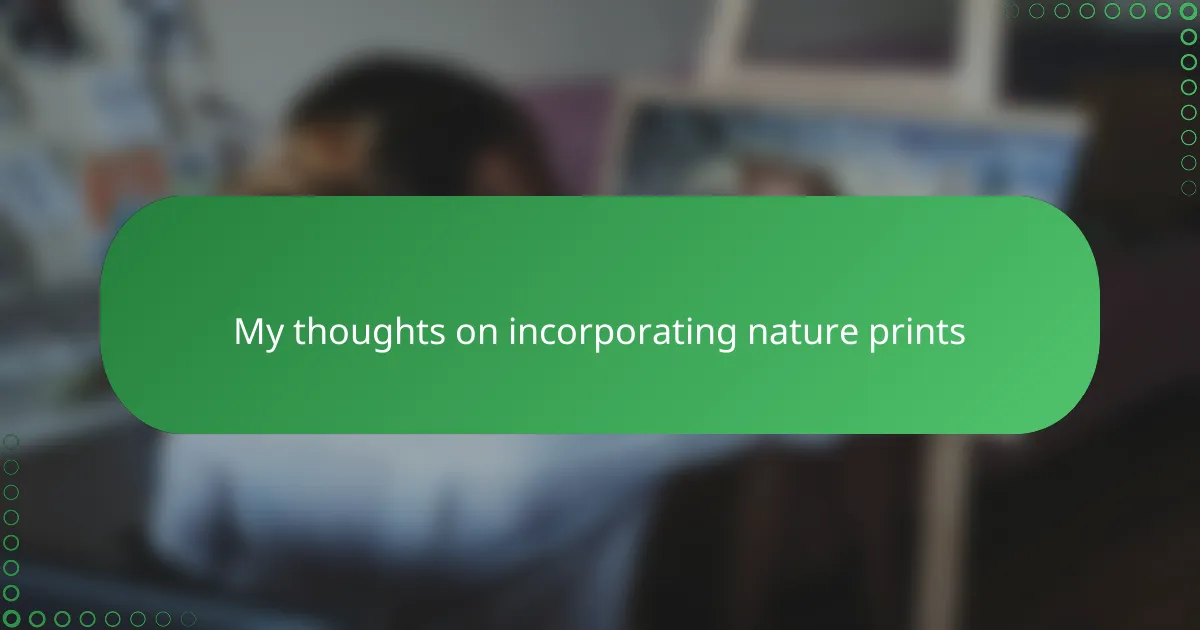Key takeaways
- Handmade paper crafts allow for unique creativity and personal expression through the use of natural materials.
- Incorporating nature prints adds authenticity and depth, creating a tactile and meaningful connection to the environment.
- Techniques such as embedding, stamping, and mixing dried elements enhance the design and surprise in the crafting process.
- Choosing fresh materials and perfecting pressure and pulp consistency are key to achieving vibrant, detailed prints.

Introduction to handmade paper crafts
Handmade paper crafts have always fascinated me because they transform simple fibers into something uniquely beautiful and tactile. The process itself feels almost meditative, a mindful escape where every sheet tells its own story. Have you ever noticed how the texture and imperfections in handmade paper add warmth and character that machine-made alternatives simply lack?
When I first tried making paper by hand, I was amazed at how versatile the medium could be. From delicate invitations to bold art pieces, each creation carries that personal touch you just can’t replicate with factory-made paper. Isn’t it wonderful how a humble sheet can become a canvas for creativity?
There’s something deeply satisfying about working with your hands to produce something so organic and one-of-a-kind. It invites you to slow down and connect with nature’s raw materials in a way that feels both grounding and inspiring. Wouldn’t you agree that this handmade quality adds a meaningful layer to any craft project?

Benefits of using nature prints
Using nature prints in handmade paper crafts brings a fresh, organic element that always catches my eye. There’s an authenticity in the delicate impressions of leaves or flowers that machines simply can’t mimic. Have you ever run your fingers over a leaf print and felt an instant connection to the outdoors? I find that touch makes each piece feel alive and unique.
What I love most is how nature prints add depth without overwhelming the design. They create subtle patterns that invite closer inspection, making every sheet invite a moment of quiet appreciation. This gentle complexity often sparks ideas I hadn’t considered before, turning a simple project into something truly personal.
Beyond aesthetics, incorporating nature prints feels like a small act of honoring the environment. I find it grounding to remind myself where my materials come from, which makes the crafting process even more meaningful. Don’t you think that this connection enhances not just the look, but the whole experience of creating?
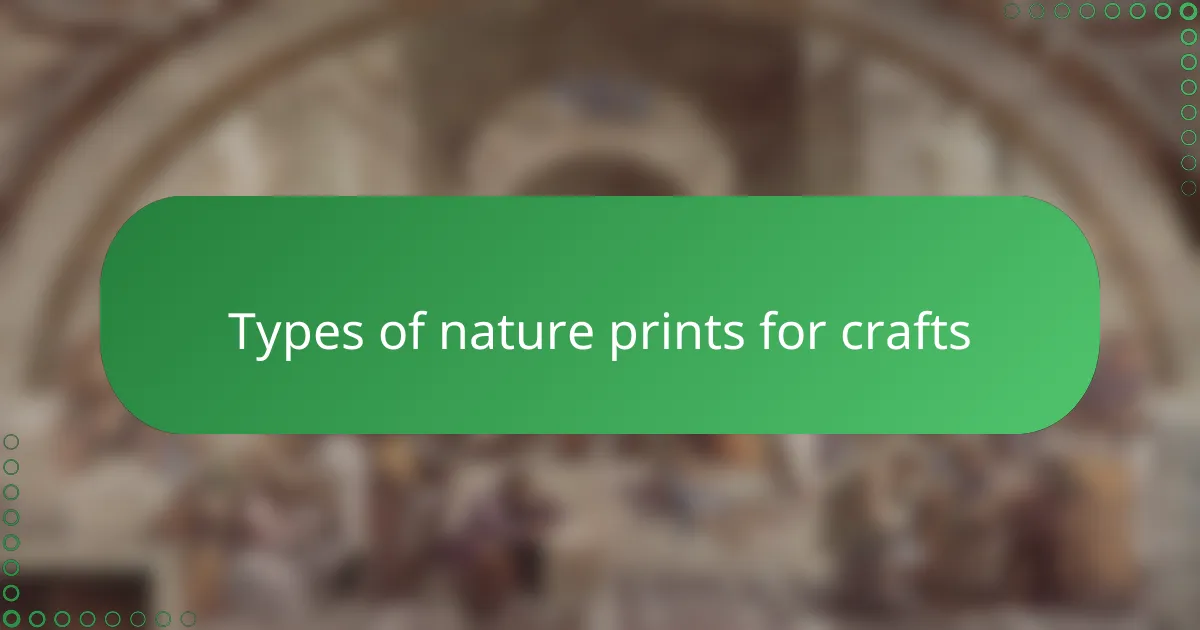
Types of nature prints for crafts
When I first explored types of nature prints for my paper crafts, I was drawn to leaf imprints. Pressing a fresh leaf onto wet pulp revealed veins and textures with such detail that each sheet felt like a piece of the forest itself. Have you ever noticed how different leaf shapes – from ferns to maples – bring their own personality to a project?
Flowers are another favorite for me. The delicate outlines of petals and subtle color traces create a softness that’s hard to achieve otherwise. I remember making a set of handmade cards with hibiscus prints, and each one seemed to carry a quiet elegance that made giving them feel truly special.
Sometimes I experiment with bark and grasses, adding a rugged or wispy element to my paper. These prints are less common but offer striking textures that tell a story of the environment beyond just the surface look. Don’t you find it fascinating how something as simple as a blade of grass can leave a lasting impression on paper?
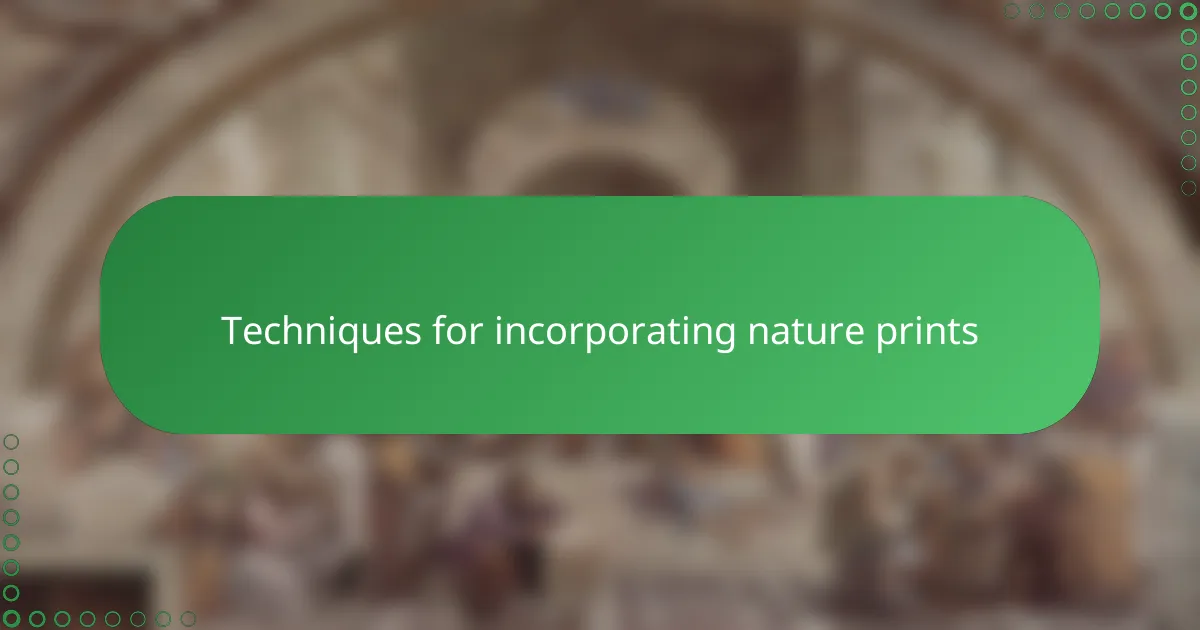
Techniques for incorporating nature prints
One technique I often turn to is embedding leaves or flowers directly into the wet pulp. It’s incredible how pressing these natural elements just before the paper dries captures their intricate details, almost like freezing a moment in time. Have you tried feeling the slight relief of a leaf’s veins within the paper? That tactile surprise always delights me.
Another method I enjoy involves using nature prints as stamps. I take a crisp leaf or textured bark, apply natural dyes or inks, and press them gently onto finished sheets. This process offers so much room for play—you can layer prints or create patterns that feel both intentional and spontaneous. Isn’t it fun to experiment and see where the shapes lead your design?
Sometimes, I mix dried petals or grasses into the pulp, letting them peek through as the paper forms. This technique adds a subtle complexity, like hidden treasures embedded in each sheet. It reminds me that nature’s beauty isn’t just visual—it’s about discovery and connection, don’t you think?
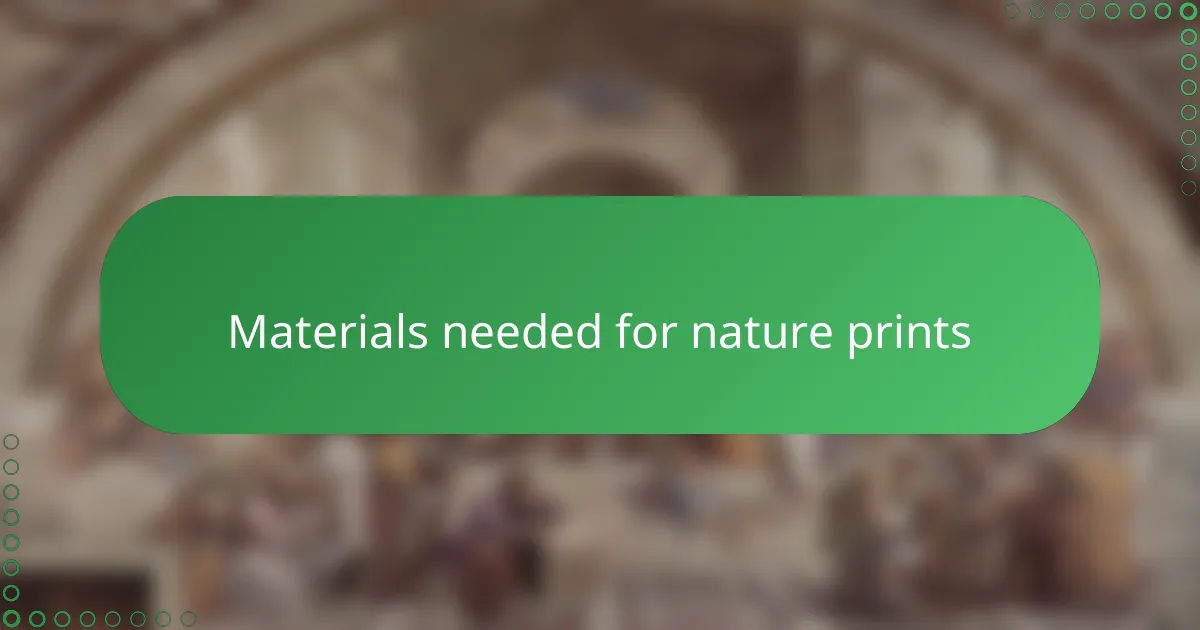
Materials needed for nature prints
Gathering the right materials for nature prints has always felt like a small adventure to me. Fresh leaves, petals, and even thin grasses become my palette, each offering a unique texture and shape that eager fingers want to explore. Have you noticed how the simplest natural objects hold endless potential when paired with handmade paper?
I usually keep a collection of natural dyes and inks nearby, along with my trusty rolling pin or soft brush to transfer those delicate patterns onto paper. Sometimes, I wonder whether the worn texture of an old leaf or the vibrant color of a freshly plucked petal makes the print more special—a question I love revisiting with each project.
Of course, the foundation is the pulp itself—a mix of recycled fibers or cotton rags that welcomes the nature prints warmly. I find that preparing this base carefully makes all the difference in how vividly the prints come to life, almost like giving nature its own spotlight on the page. Does that attention to detail change how you feel about the final piece too?
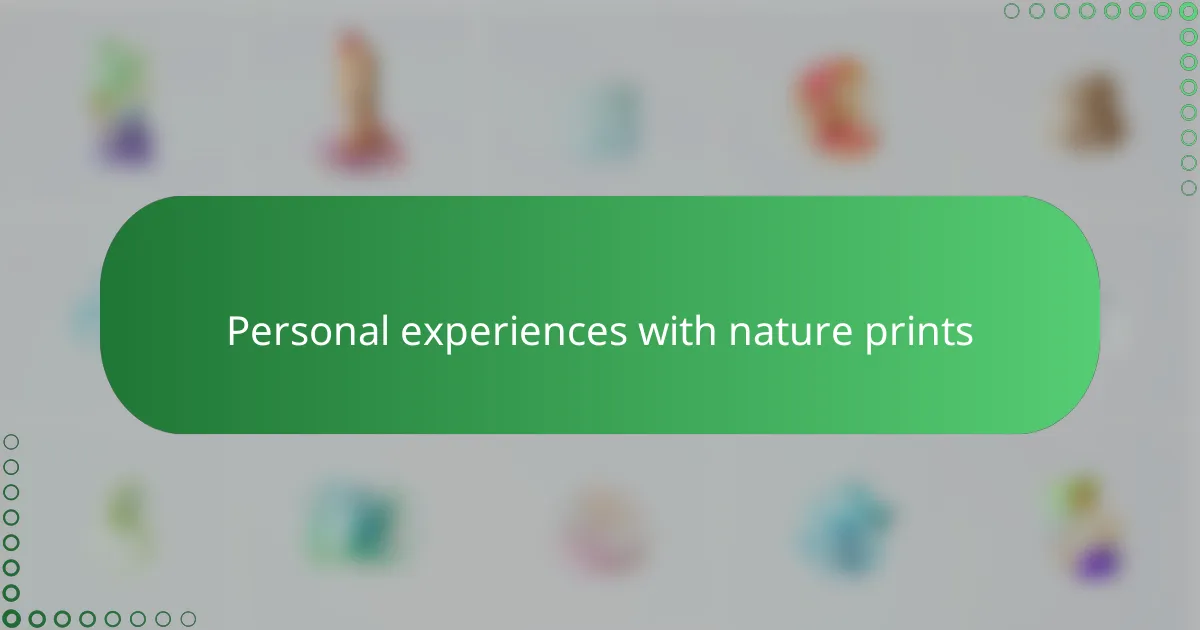
Personal experiences with nature prints
When I first incorporated nature prints into my paper crafts, I remember feeling a rush of excitement watching a simple leaf transform into a delicate imprint. It was like capturing a tiny piece of the outdoors—a moment frozen forever on a handmade sheet. Have you ever felt that same thrill when a natural pattern unexpectedly appears in your work?
Sometimes, the process surprises me in the best way. Once, I pressed a fern frond into wet pulp and, after drying, noticed the veins shimmer subtly under light, something I hadn’t anticipated. That little discovery made the entire crafting session feel like a quiet celebration of nature’s complexity. Don’t those unplanned details make projects feel more alive?
I’ve also found that nature prints deepen my connection to each piece beyond just aesthetics. There was a time I crafted paper with flower petals collected during a walk, and knowing where those petals came from infused my work with a personal story. Isn’t it amazing how these organic touches turn handmade paper into something much more meaningful?
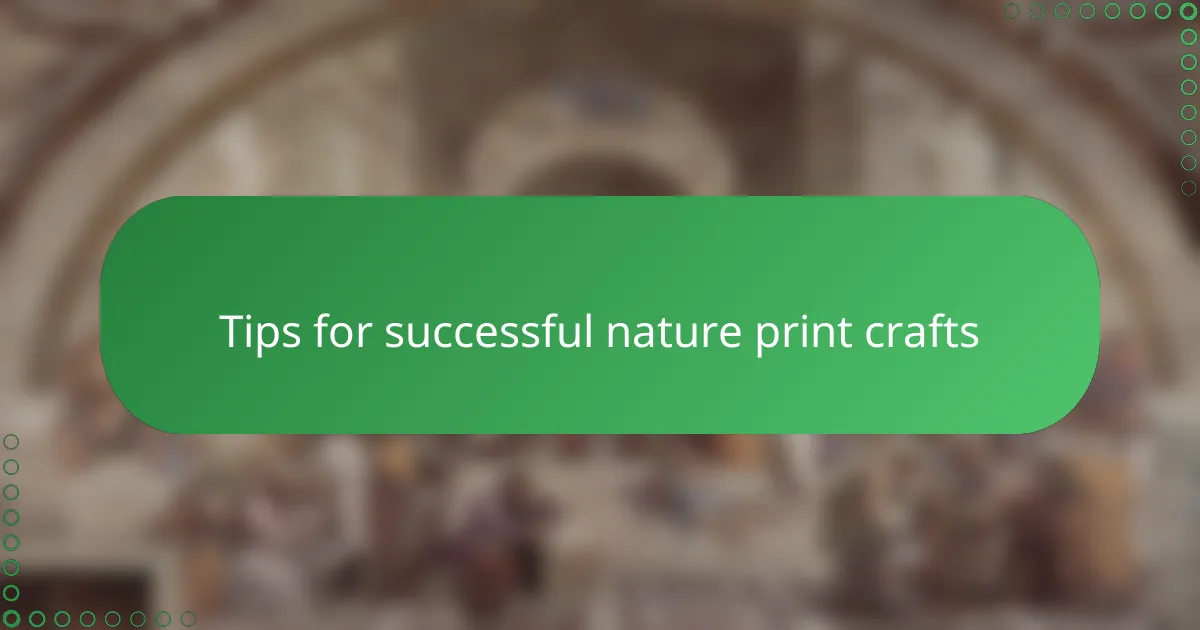
Tips for successful nature print crafts
One thing I’ve learned is to choose your natural materials carefully—freshness really matters. I remember trying to press some leaves that were a bit dry, and the prints came out faint and brittle, lacking the vibrant detail I’d hoped for. Have you noticed how a plump, freshly picked leaf holds its veins like a tiny roadmap, making the imprint so much richer?
Another tip that’s helped me is to experiment with pressure and timing during the printing process. Too much force can crush delicate petals, while too little won’t transfer enough detail. I often find myself asking, “Am I pressing gently enough to preserve texture but firmly enough to capture the essence?” It’s a bit of an art that improves with patience and practice.
Also, don’t overlook the importance of your paper pulp’s consistency. I once made the mistake of using a mix that was too watery, causing prints to blur and edges to fade. Since then, I pay close attention to the thickness—it’s like setting the perfect stage for nature’s impressions to shine. Have you found that dialing in this balance transforms the difference between a good print and a stunning one?
